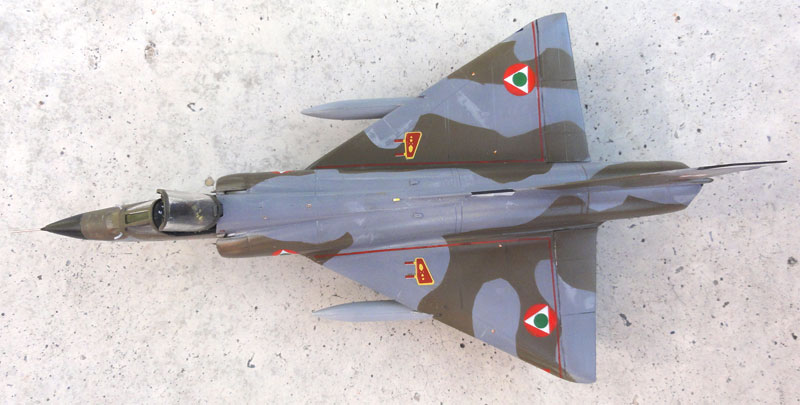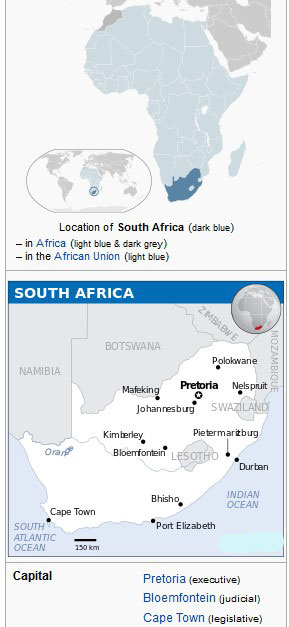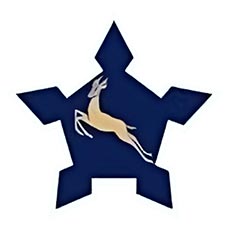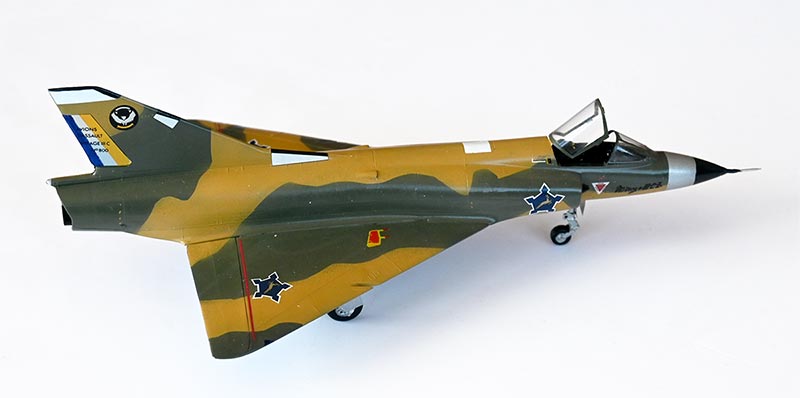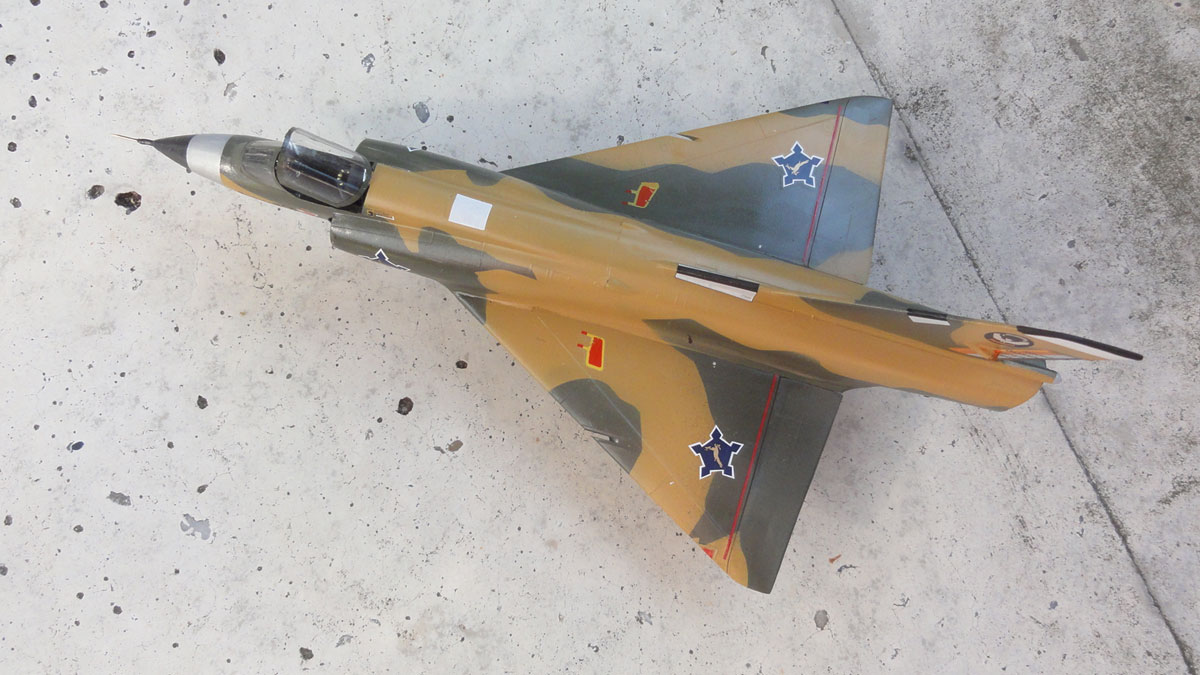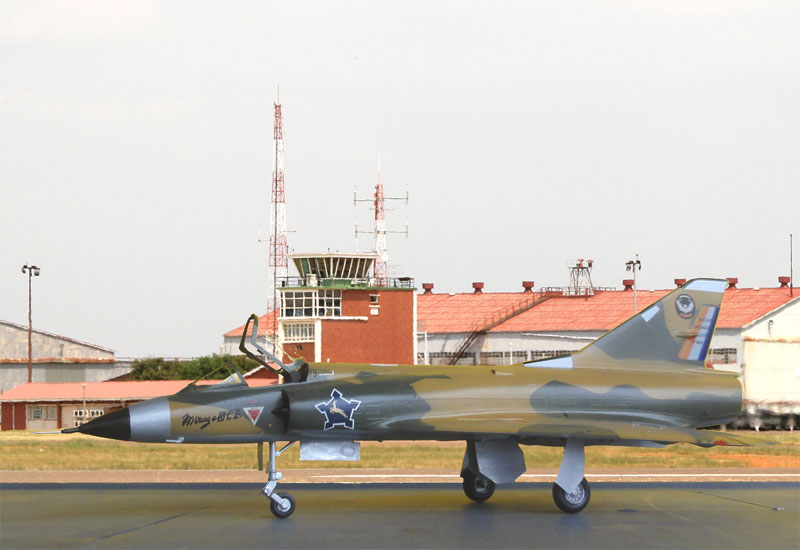[ Page 3 ]
More than a year after completing the previous Mirages, more Mirages were made.
A Heller Mirage was made and finished as a Belgium Air Force Mirage 5 BA (V BA). The type entered service in 1970 as replacement of the old F-84F Thunderstreak. The Mirage V BA had no radar and was used exclusively for ground attack.
The brake disks on the main wheels are slightly different as on a Mirage 3 ( III ) but the Heller kit parts were used. I retained the kit (raised) panel lines.
The BAF Mirage was special as it had an arrestor hook fitted as well. The arrestor hook was made from strip. Other tiny intakes and scoops were added as weel from scrap.
Some smaller intakes were made from card, particularly at the lower area near the canons (see page 1 as done at the other Heller kits...)
The cockpit interior was mainly black. The model fin tip got a black edge and small ECM fairings made from thin rod and plastic card. Small anti-collision lights were made by cutting out nothes in the wing leading edge tip and , after painting red and blue, filled with Micro Kristal Kleer.
Also suggested was the later installed chaff dispenser on the lower fuselage tail.
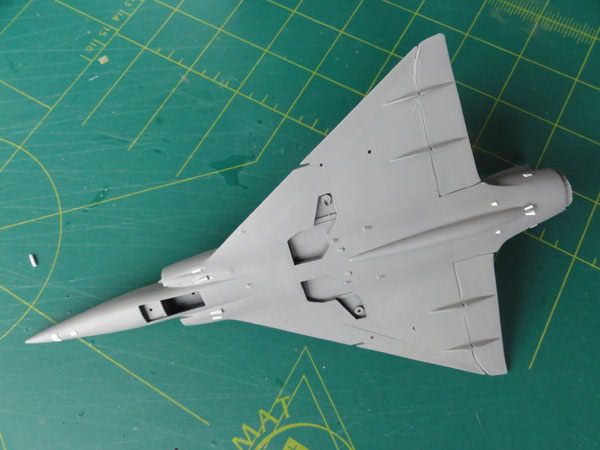
Here the assembled Heller 1/72 model
for the Belgian AF is seen with a grey base coat using Revell Aqua light
grey #371 to check for any gaps and errors and applied with the airbrush.
I had an old IPMS Belgium magazine (kit #54 of Summer 1984) and also a very old DACO decalset D7222 in the decal box and it had markings for a Mirage V of with code "BA 26". It sports a wrap around camouflage scheme applied after 1981 and indicates the appropriate Fed.Std colours.
On the model were used these acrylics:
FS 34102 green using Gunze Sangyo
303;
FS 30219 tan using Gunze Sangyo 310;
FS 34064 olive drab using Gunze Sangyo
304 (or use Revell 361 acrylic).
The camouflage pattern varies considerably
between individual Mirages of the Belgian Air Force. (note that older BAF
Mirages had light grey/white lower surfaces FS 36622).

Time to apply the decals. As usual
to prevent "decal silvering", the model got as other models a couple of
gloss coats with the airbrush using Johnson Future, thinned with 20% IPA
Alkohol.
The DACO decals were fine. The "yellow"
no step markings were used, but these vary between aircraft.
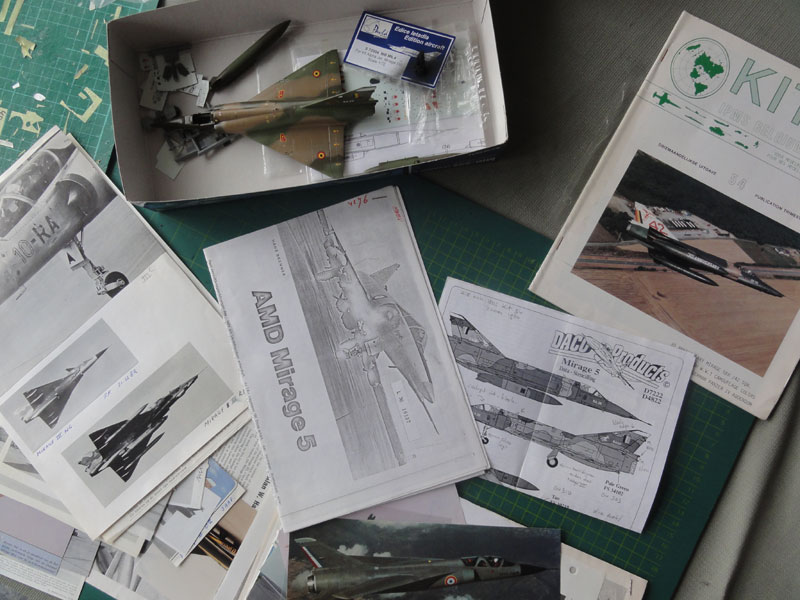
After decalling, the rest was completed.
Undercarriage fitted and also a couple of large fueltanks. The wheel bays
and gear legs got a metal aluminium finish painted.
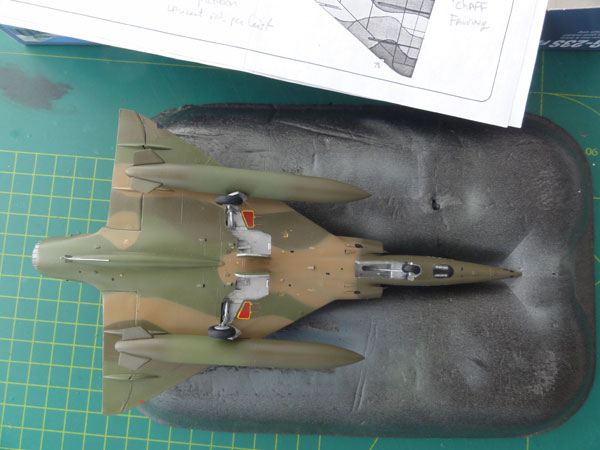
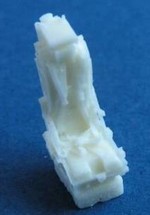
Again the simple kit seat was
replaced
with a Martin Baker mk.4 resin seat from PAVLA #S72004. (Note: from
1990 the Belgian Mirages got the Martin Baker mk.10 seat).
Some tiny cockpit
details were added as well from scratch.
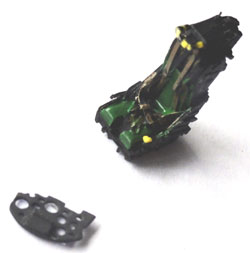
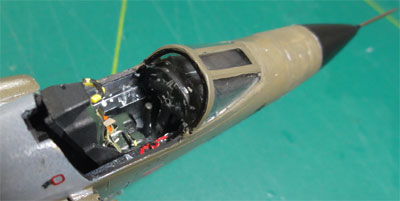
After this, some areas got a light overspray with the airbrush using the same 3 camo colours. This "blends in" the decals into the model and gives a very good scale effect.
After that, the model got a semi-gloss coat to get an even sheen and protect the decals. Johnson Future thinned with 20% iso propyl alkohol was used with some 10% Tamiya matting acrylic X21 "Flat base" mixed in.
The canopy was painted and set open with some tiny mirrors added as well. The canopy at the rear can be fixed with a small piece of etched metal or aluminium BBQ plate bended bit and superglue.
The Heller kit exhaust was covered with a red cover plate and some "remove before flight" vanes were added. A metal pitot tube was made from a piece of metal needle.
That completed this kit which had
been in the unbuilt stack for far too long.
![]()
Mirage 5
BA of the Belgische Luchtmacht / Force Aerienne Belge.
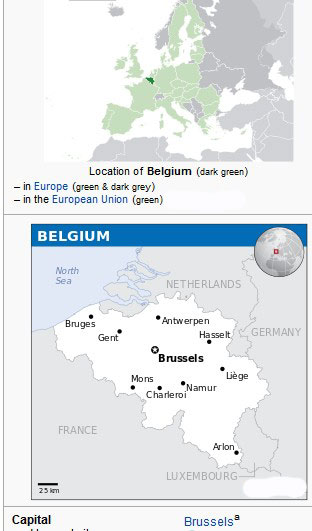
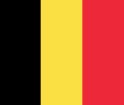
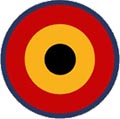
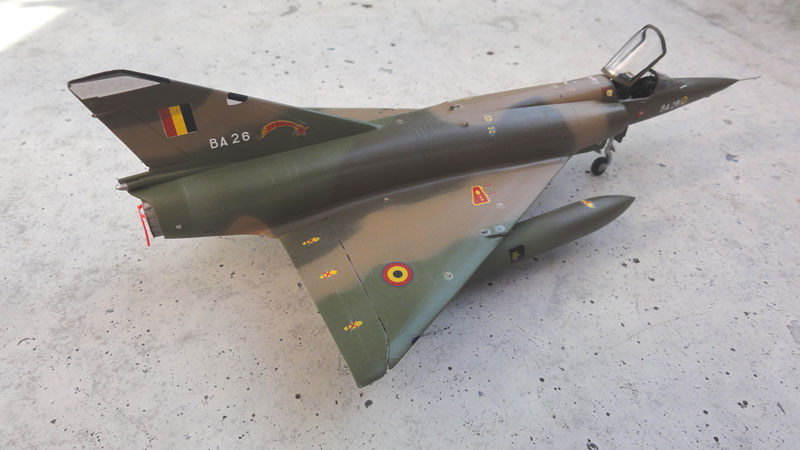
Note that this BAF Mirage 5 BA does
not bear any walkways lines as seen on most other Mirages.
Page 2
Page 3
Page 4
This old
Revell
kit #H225 has a very simple built-up with only a raw seat as interior.
It appeared in various boxes and releases (probably the same kit with different
decals? ).
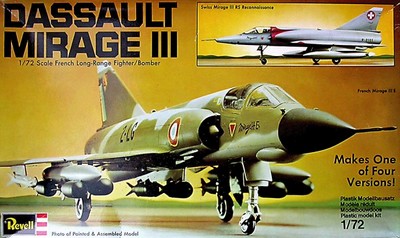

and another box...

This kit no. #H225-3800 , dated 1976
had green plastic.
It has two decal options for
1. Mirage IIIE / IIIR of Armee de
l'Air camouflaged plane
2. Mirage IIIS or III RS of Swiss
Air Force in natural metal.
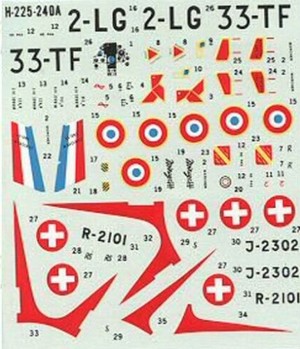
What is special of this kit: multiple version choices are possible and it has a mix of raised and inscribed panel lines! And typical of the old days, a removable Adour engine is in the kit! (I kept this out). The parts are in rather hard green plastic.


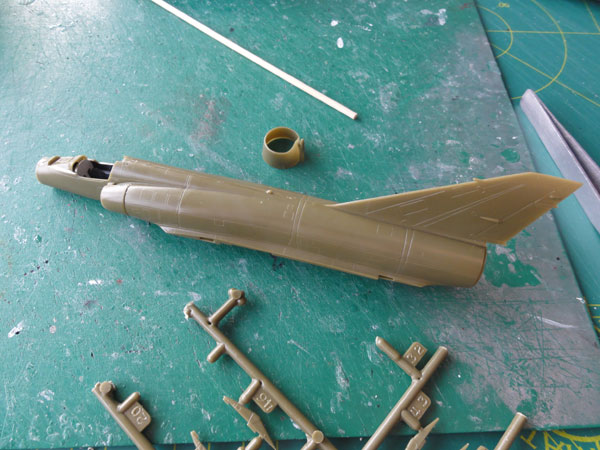
For the Mirage 3 "R" versions, in this kit a clear reconnaissance nose is included. The cockpit has a panel and floor but the seat is very basic. A separate part for the lower nose Doppler fairing is in the kit.
Opted was a model of a Lebanon Air Force Mirage III EL and this version had no doppler radar fairing below the nose so this part was not installed.
The kit also comes with "bombs" besides the large fuel tanks (a very special configuration indeed developed by Dassault) and "Sidewinders" (but these supposed to be French Magic missiles?).
OK, let's
start modelling
The nose gear bay was opened up and
a simple "roof" added from cart. Than the model was simply assembled. The
rear tail exhaust needs a piece of pipe to add depth.
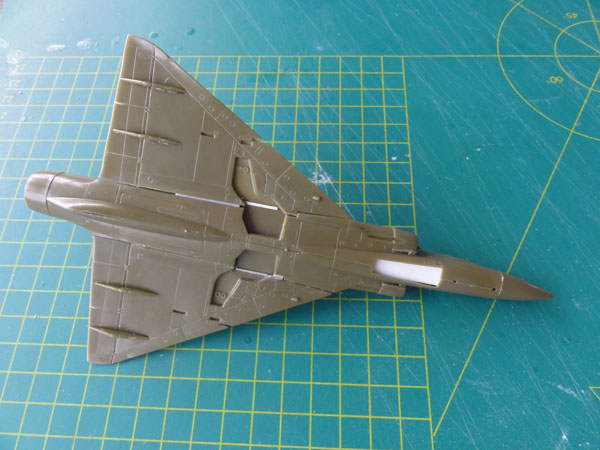
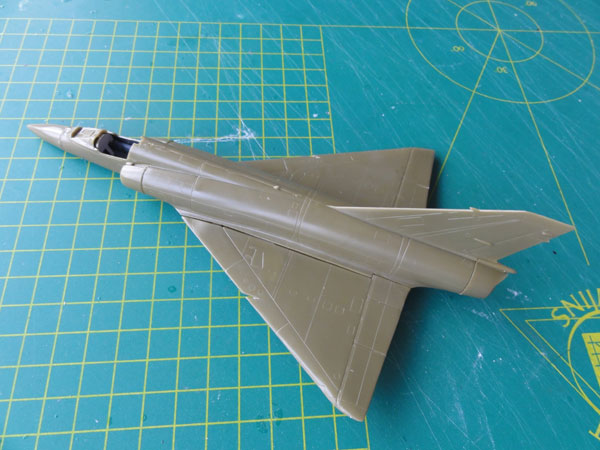
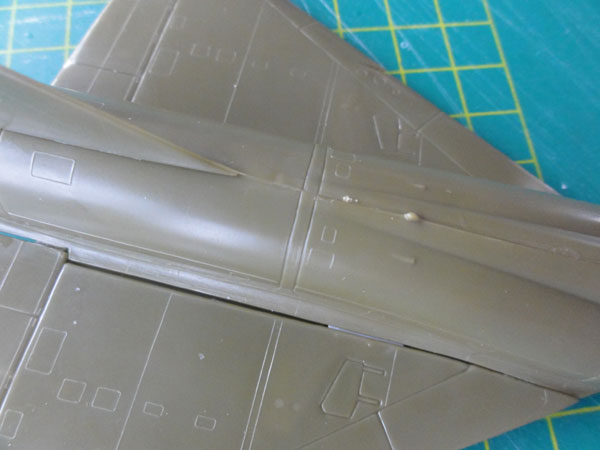
Large gaps at the wing-fuselage joints
need filling. Note also the strips of plastic to close the large gaps at
the wing roots.
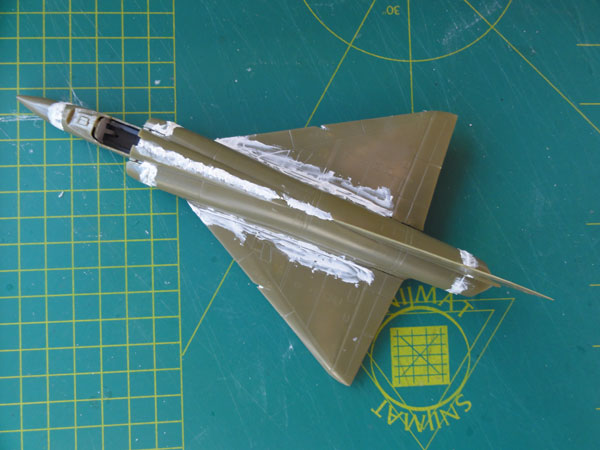
Filler, filler ....
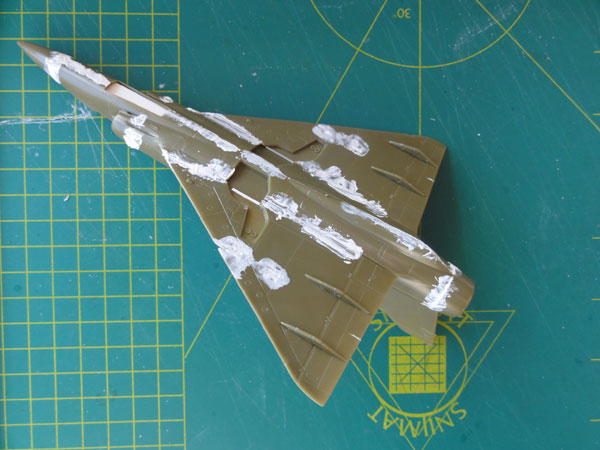
and ... sanding was needed.

Inside the main gear bays some simple
details were added made from bits and pieces. Wing pylons gaps were also
filled. Also, a small dorsal fin was added in front of the vertical tail
made from thin card. These vary per Mirage so check photos. And NO doppler
fairing under the nose was needed for the BAF Mirage V.
The model next got a first grey base coat.
After checking and correcting any flaws, the camouflage scheme was applied. The Lebanese colours seemed to be the Dassault company standard. Airbrushed colours used were Gunze Sangyo acrylics, with #308 for the lower surfaces, #304 for the olive drab and #305 mid grey.
The demarcations between colours are "hard", so low tack masking film from Revell was used. It was cut in parts and set onto various areas looking at drawings and photos of real Mirages. There seems to be a sort of common pattern used at many air forces as standardized by Dassault.

I had very old ESCI decals with various roundels but are very bad and fall apart. I added at least 5 coats of Johnson Future varnish with the airbrush. But even than..... better use the Microscale Decal Film coat.
I decided to apply for the roundels another approach: I found Austrian AF decals in the spares box and added green circles to get the Lebanese roundels.
The needed "arabic numbers" were hand painted in black with a fine paint brush. The Lebanese flag came from the ESCI set.
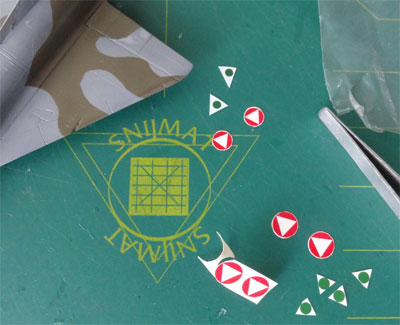
As usual to prevent "decal silvering", the model got as other models a couple of gloss coats with the airbrush using Johnson Future, thinned with 40% Alkohol.
The nose was painted black. Also red walkway lines are on Lebanese Mirage aircraft. Completing the model was similar as other Mirages, adding the landing gears that were painted aluminium and so on. Also, the small thin fueltanks were added. A couple of tiny pitot tubes near the wind shield were added from rod.
Finally, the model got a semi-gloss
coat to get an even sheen and protect the decals.
The kit exhaust was covered with a
red cover plate.
[area: 10,450 sq.km | population: 7 million | capital: Beirut | GDP: < 2,000 USD nominal per capita ]
The Lebanese
air force ("Al Quwwat al-Jawwiya al-Lubnaniya") was founded in 1949 assisted
by RAF advisors and got British aircraft. The main base was at Khaldeh/Beirut
and Rayak. A first Vampire T55 trainer was received August 1953 followed
by six Vampire FB.52
aircraft and another two T55 trainers used by Pursuit Bomber Squadron,
later no.1 squadron. In 1956 tensions increased because of the Suez crisis
and Lebanese leadership rejected to join the proposed "United Arab Republic"
of Nasser. The UK delivered six Hunter F.mk 6 fighters in November 1958
and probably another seven refurbished Vampire FB.5 and FB.9.
Lebanon
received
probably 10 Mirage 3 EL aircraft between 1967 and 1969 and also some
trainers. (later, some of these went in 2000 to Pakistan).
Current aircraft
in the Lebanese armed forces are mainly helicopters.

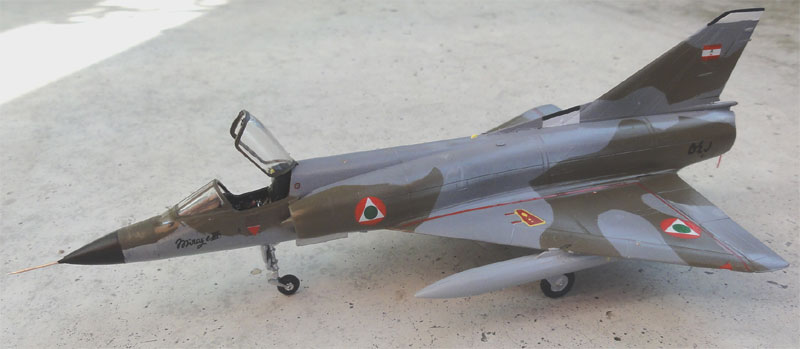
A nice Mirage III EL of the Lebanese
Air Force " Al Quwwat Al Jawwiya Lubnaniya "
circa 1970 at Kleyate / Kleiat, near Tripoli in North Lebanon.
This model fits nicely in my World
Air Forces model collection.

.... Continueing now with the very old Airfix kit as described on previous page...
The Mirage III C will be made as an aircraft of the South African Air Force (SAAF) in the "apartheid" period of 1965. I believe a restored aircraft is in South Africa and it shows a metal area aft of the radar nose. This was set on the model as well.
The Airfix kit exhaust part was lost
and a new one was made. It has at the rear a V shape, and this was
made from an old tank store.
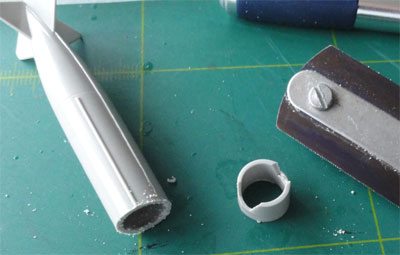
The doors in the kit were very thick plastic bits, so new ones were made from thin aluminium foil (as from a BBQ through away plate). Use the kit parts as patterns, some extra layers gave inside rib detail.

Camouflaged, the model got light grey
Gunze
Sangyo 308 with a bit aluminium mixed in at lower surfaces, and green
Gunze 309 and Revell Aqua 88 "tan" acrylic paints applied with the airbrush.
The demarcations are "hard", so masking film was used.

Having a spare thin vacuform canopy
from the PJ kit, this was used in stead
of the thick Airfix part.
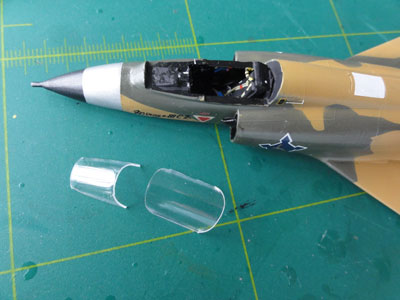
The model would get many decals,
so it was glossed with Johnson Future as usual to prevent decal "silvering".
The SAAF national "castle" decals used came from an after market set called SAAF, they look as coming from Xtradecal. Please note to ensure the correct heading of the "springboks". Note that the number roundels varied in time (and also their style).
A few red walkway lines from decals were added as well as the usual air brake "no step" panel. A couple of tiny bits like pitot tubes were added and the mirrors inside the canopy. The kit is quite nice in the collection despite being very old.
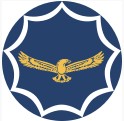
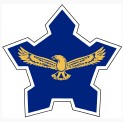
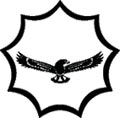
[area: 1,221,000 sq.km | population: 60 million | capital: Pretoria | GDP 6,500 USD per capita nominal ]
South Africa is a multiethnic country that had its coastal areas colonized by Dutch and British settlers before 1900 with the Transvaal republic. In 1910 it became more independent and during the years a rule of apartheid introduced. Under internal and international pressure, apartheid was abolished in the early 1990s and a new democratic system with equal voting introduced. A new South african defense force was set-up.
Earlier in 1913 a Flying School and Air Corps was established and a few Farman acquired as well as BE-2c biplanes. In 1920 the Air Force was formally established and the British imperial government supplied about 100 aircraft such as Avro 504, DH.9 and SE.5a biplanes. Swartkop near Pretoria was the first base. In the 1930s locally Wapiti biplanes were produced followed by Hawker Hartbees and Avro Tutors. In 1938 Waterkloof base was established and in 1940 just some 6 Hurricanes, a Battle and a Blenheim were available. War activities never reached the country, just coastal flights were made with Ansons and even JU-86Z and in Northern Africa, Boston bombers were deployed against the Axis forces. Ops later were carried out for the Allied war effort in the Mediterranean. From 1942 aircraft like the Maryland, Beaufort and Lodestars were used also to secure the island of Madagascar.
After the Second World War F-51D Mustangs were used in Korea to support the Allied effort and from 1953 after training in Japan with F-86 Sabres marked with the "springbok roundel". From 1950 DH Vampires and 34 Canadair Sabres were acquired as well a few Sunderlands. In the 1960s and 1970s many British aircraft types were used like 9 Canberra's, 16 Buccaneer, 8 Shackleton MR3 to replace the Sunderland but also some 40 Puma helicopters. A U.K. arms embargo in 1965 was raised so acquisition was done types like with over 50 Mirage III and F-1 fighters and some 50 MB.326 Impala's license made by the local company Atlas and more than 40 Alouette III and 14 Super Frelon helicopters. Some C-130 and C-160 transports were acquired in the 1960s. From the late 1970's the SAAF participated in border wars into Angola, Zambia, Zimbabwe, Botswana and Mozambique. In 1977 an U.N. arms embargo was raised and more local arms industries set-up like Denel. The Mirage III was converted into the Cheetah and the Rooivalk helicopter first flew in 2000. In the early 1990s, apartheid ended. In 2003 the first BAe Hawks were delivered and PC-7 trainers. Others are BK117 and A109 helicopters and more recently Super Lynx.
Some 17 SAAB JAS39C and 9 dual -D Gripen fighters were acquired and delivered from 2009 but usage is limited due to lack of pilots and finances.
There are a dozen air bases with Makhado (Trichardt) north of Johannesburg being the Gripen base. Waterkloof is the main transport base with types like C212, a few C-130, Caravan and Beech 200 and Falcons.
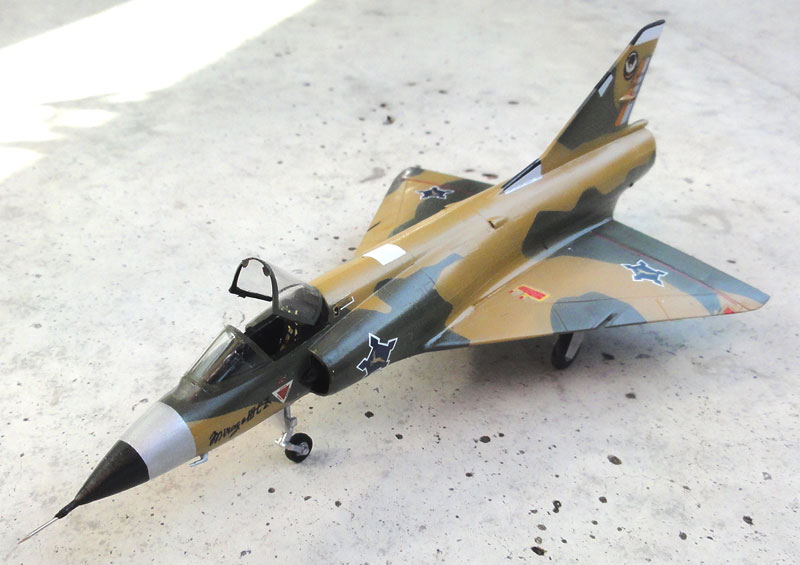 Mirage III CZ of the
SAAF! The South African Air
Force (SAAF) received 16 Mirage III CZ from 1963 and
also operated these from Waterkloof air base near Pretoria.
Mirage III CZ of the
SAAF! The South African Air
Force (SAAF) received 16 Mirage III CZ from 1963 and
also operated these from Waterkloof air base near Pretoria.
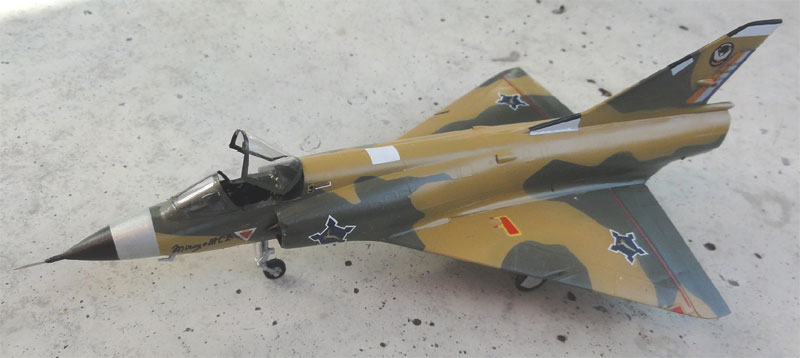
This SAAF Mirage is also a nice companion
to the SAAF Canberra made
over 15 years ago....

(c) Copyright Meindert "designer"/ All rights reserved. Your comments are welcomed by webmaster
Created this page September 8, 2015

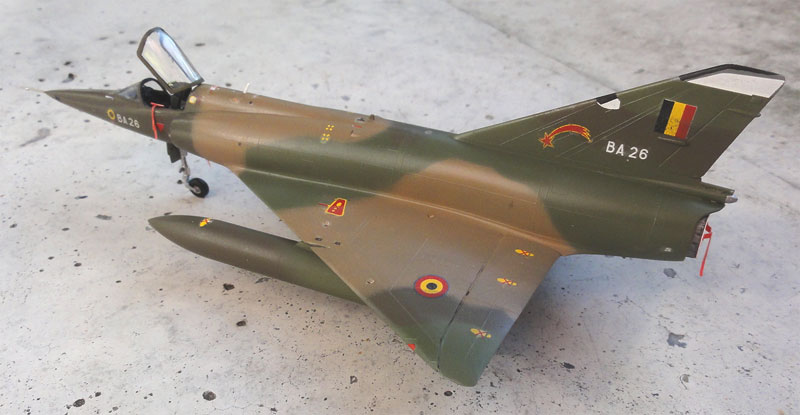
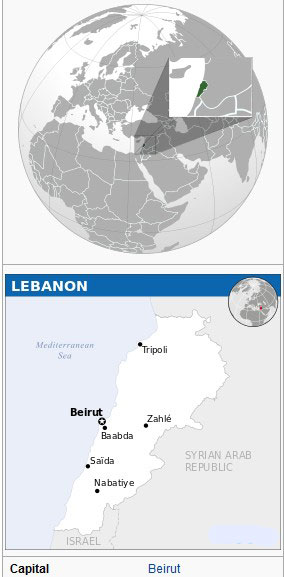 ...
... ....
....
